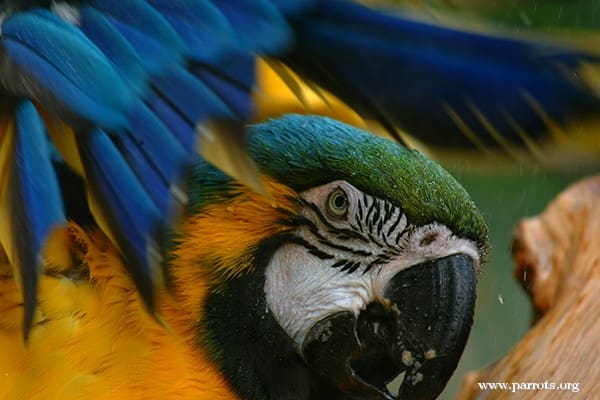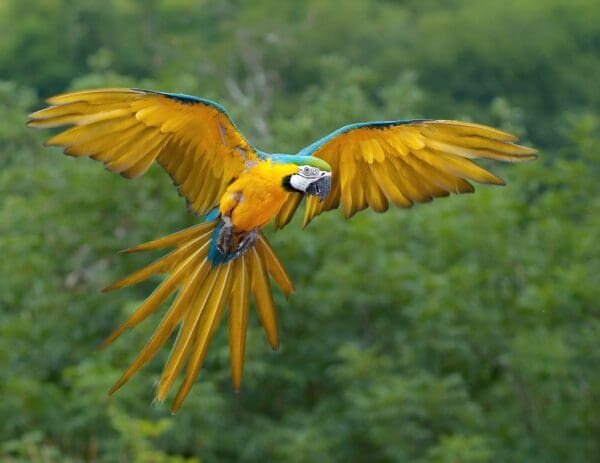Blue-and-yellow Macaw
Also known as:
Blue-and-gold Macaw, Yellow-breasted Macaw, Blue Macaw
Also known as:
Blue-and-gold Macaw, Yellow-breasted Macaw, Blue Macaw
![© Eduardo Efrain da Silva [CC] A closeup of a wild Blue-and-yellow Macaw](https://parrots.org/wp-content/uploads/2023/01/wpt_Blue-and-yellow-Macaw_1091-35-100x100.jpg)




















DID YOU KNOW?
Paired birds often fly so close to one another that their wings touch.

Ara

ararauna
Size:
86 cm (33.5 in)
Weight:
1040-1286 g (36.4-45 oz)
Subspecies including nominate:
one
Colour Adult:
Both adults bright blue above, mostly golden-yellow below; with long blue and yellow tail; bare white facial disc with fine lines of green feathers; throat black; crown and forehead green. Large black/grey beak. Eye yellow.
Colour Juvenile:
As in adult but with grey/brown eye.
Call:
Loud raucous calls, some harsh. Most calls are guttural with varying sounds.
More Information:
Content Sources:
CITES
BirdLife International
Cornell Lab of Ornithology/Birds of the World
A Guide to Parrots of the World, Juniper and Parr, 1998
Parrots of the World, Forshaw and Cooper, 1977,1989. 2010 edition
Parrots of the World, Forshaw, 2006.
Parrots in Aviculture, Low, 1992.
Psittacine Aviculture, Schubot, Clubb and Clubb, 1992.
Captive Status:
Common in captivity.
Longevity:
60 yrs
Housing:
Should have access to a large enclosure (15 m (50 ft) long) in which to fly for part of the year.
Diet:
Soaked or sprouted sunflower seed; walnuts, peanuts, pecans, Brazil nuts, pine nuts; corn on the cob, banana, orange and other fruit. Complete kibble for macaws.
Enrichment:
Large macaw toys, chewables (fir branches, pine cones, bird-safe wood), large perches, swings, ladders; regular bathing.
Nest Box Size:
Horizontal box, 16″ x 16″ x 48″ (40.6 cm x 40.6 cm x 122 cm) or 35 gallon (9.2 L) pickle barrel.
Clutch Size:
2 to 4
Fledging Age:
90-100 days.
Hatch Weight:
—
Peak Weight:
—
Weaning Weight:
—
World Population:
Unknown but described as uncommon. Decreasing.
IUCN Red List Status:
Least Concern
CITES Listing:
Appendix II
Threat Summary:
Still fairly common in much of its range, however, is declining with habitat loss in many peripheral areas. Has been subject to very heavy trapping for trade (over 60,000 birds as of 2015). This species is suspected to lose 20.9-35.3% of suitable habitat within its distribution over three generations (38 years) based on a model of Amazonian deforestation. However, given the species’ tolerance of fragmentation/degradation/edge effects and/or the extent of overall losses, it is suspected to decline by <25% over three generations.
Range:
Large range – E Panama and lowlands of South America to SE Brazil, Bolivia and Paraguay.
Habitat:
Occurs in wooded areas, usually near water, including edge of lowland humid forest, gallery forest in savanna, savanna with scattered trees and palms, swamp forest and palm swamp. Sometimes forages in open country. Up to 500 m (1640 ft).
Wild Diet:
Feed on seeds of Spondias, Terminalia, Hura, Enterolobium, Inga, Parkia, Platypodium, nectar of Quararibea, flowers of Combretum, fruit and/or petioles of Ficus, pulp of Sloanea, Schwartzia, Brosimum, Sorocea, aril of Otoba, leaves of Iriartea, mesocarp of Scheelea and Pouteria, and undetermined parts of Mauritia; Maximiliana palm nuts in Surinam.
Ecology and Behaviour:
Feeds quietly in top of forest canopy; large numbers congregate at riverbank locations, with other parrot species, to take clay soils. Usually found in pairs, but often in noisy flocks of up to 25 birds.
Clutch and Egg Size:
2 to 4, elliptical 46 x 36 mm (1.8 x 1.4 in)
Breeding Season:
January-March in Surinam, April-May in Trinidad, December-February in Colombia. Nest is in dead tree cavity.




















